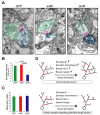Insulin receptor signaling in the development of neuronal structure and function
- PMID: 20230616
- PMCID: PMC2843688
- DOI: 10.1186/1749-8104-5-7
Insulin receptor signaling in the development of neuronal structure and function
Abstract
Sensory experience plays a crucial role in regulating neuronal shape and in developing synaptic contacts during brain formation. These features are required for a neuron to receive, integrate, and transmit signals within the neuronal network so that animals can adapt to the constant changing environment. Insulin receptor signaling, which has been extensively studied in peripheral organ systems such as liver, muscle and adipocyte, has recently been shown to play important roles in the central nervous system. Here we review the current understanding of the underlying mechanisms that regulate structural and functional aspects of circuit development, particularly with respect to the role of insulin receptor signaling in synaptic function and the development of dendritic arbor morphology. The potential link between insulin receptor signaling malfunction and neurological disorders will also be discussed.
Figures






Similar articles
-
Insulin receptor signaling regulates synapse number, dendritic plasticity, and circuit function in vivo.Neuron. 2008 Jun 12;58(5):708-19. doi: 10.1016/j.neuron.2008.04.014. Neuron. 2008. PMID: 18549783 Free PMC article.
-
Signaling mechanisms that coordinate the development and maintenance of dendritic fields.Curr Opin Neurobiol. 2012 Oct;22(5):805-11. doi: 10.1016/j.conb.2012.04.005. Epub 2012 May 9. Curr Opin Neurobiol. 2012. PMID: 22575709 Review.
-
Dendritic refinement of an identified neuron in the Drosophila CNS is regulated by neuronal activity and Wnt signaling.Development. 2010 Apr;137(8):1351-60. doi: 10.1242/dev.044131. Epub 2010 Mar 10. Development. 2010. PMID: 20223760
-
Synapse formation in developing neural circuits.Curr Top Dev Biol. 2009;87:53-79. doi: 10.1016/S0070-2153(09)01202-2. Curr Top Dev Biol. 2009. PMID: 19427516 Free PMC article. Review.
-
Retrograde signaling at central synapses.Proc Natl Acad Sci U S A. 2001 Sep 25;98(20):11009-15. doi: 10.1073/pnas.191351698. Proc Natl Acad Sci U S A. 2001. PMID: 11572961 Free PMC article. Review.
Cited by
-
Maternal Lead Exposure Impairs Offspring Learning and Memory via Decreased GLUT4 Membrane Translocation.Front Cell Dev Biol. 2021 Feb 25;9:648261. doi: 10.3389/fcell.2021.648261. eCollection 2021. Front Cell Dev Biol. 2021. PMID: 33718391 Free PMC article.
-
IκB kinase/nuclear factor κB-dependent insulin-like growth factor 2 (Igf2) expression regulates synapse formation and spine maturation via Igf2 receptor signaling.J Neurosci. 2012 Apr 18;32(16):5688-703. doi: 10.1523/JNEUROSCI.0111-12.2012. J Neurosci. 2012. PMID: 22514330 Free PMC article.
-
Release of Soluble Insulin Receptor From Neurons by Cerebrospinal Fluid From Patients With Neurocognitive Dysfunction and HIV Infection.Front Neurol. 2019 Mar 26;10:285. doi: 10.3389/fneur.2019.00285. eCollection 2019. Front Neurol. 2019. PMID: 30972014 Free PMC article.
-
Antagonistic regulation by insulin-like peptide and activin ensures the elaboration of appropriate dendritic field sizes of amacrine neurons.Elife. 2020 Mar 16;9:e50568. doi: 10.7554/eLife.50568. Elife. 2020. PMID: 32175842 Free PMC article.
-
The role of transthyretin in cell biology: impact on human pathophysiology.Cell Mol Life Sci. 2021 Sep;78(17-18):6105-6117. doi: 10.1007/s00018-021-03899-3. Epub 2021 Jul 23. Cell Mol Life Sci. 2021. PMID: 34297165 Free PMC article. Review.
References
Publication types
MeSH terms
Substances
Grants and funding
LinkOut - more resources
Full Text Sources

